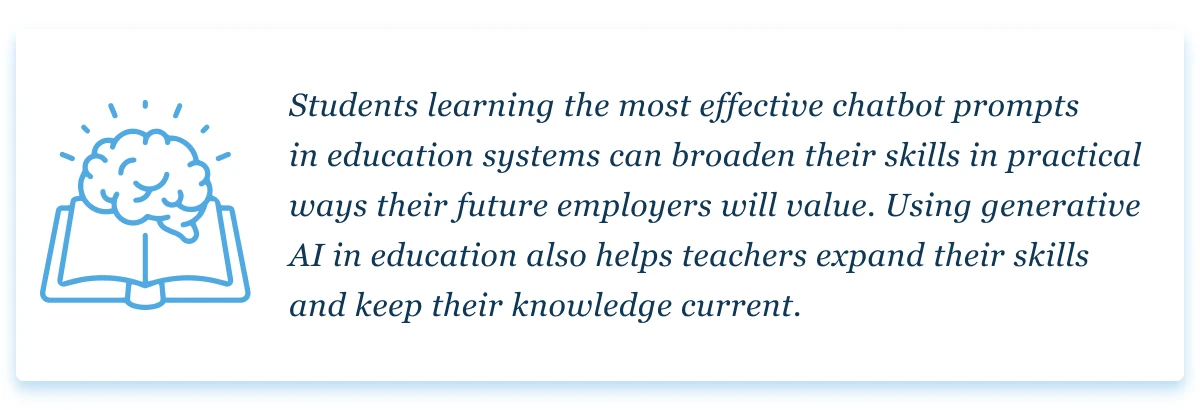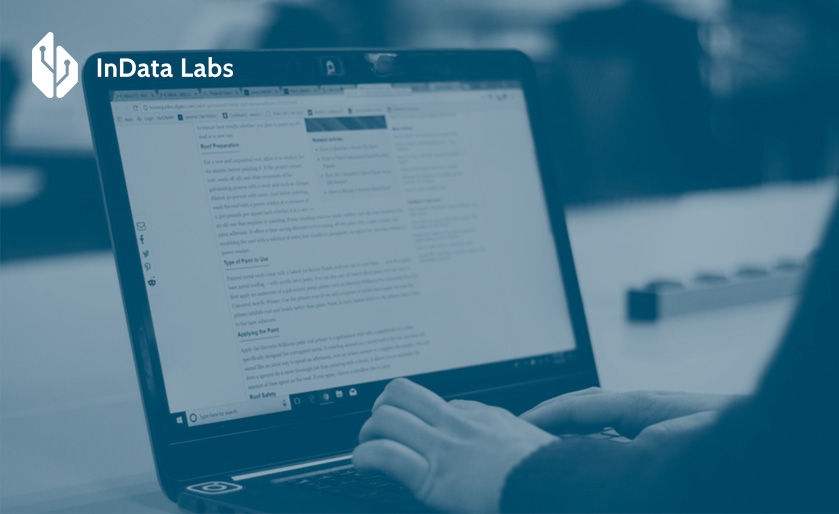Artificial intelligence (AI) has changed many industries, processes, and learning tools. Generative AI in education has been a much-discussed topic lately, mainly as teachers wonder how best to use it. ChatGPT was one of the first of these tools made widely accessible to people for free. It works with neural network models known as generative pre-trained transformers (GPT).
ChatGPT is a large language model (LLM), as are many tools that function similarly. LLMs are trained on vast amounts of text, making them able to offer responses on virtually any topic.
As teachers interacted with the chatbot’s interface, many were amazed by how it answered their prompts in seconds. They quickly realized that the generative AI impact on education would be substantial but that they’d need to adjust their teaching methods and adapt to how students might use the tool.
How widespread is the use of generative AI in education?
In the days shortly after generative AI tools reached the mainstream and people started testing them, many educators realized these offerings would change their work. They recognized the need to familiarize themselves with the possibilities for integrating these resources into the curriculum. Educators also understood that some students would probably interact with generative AI products.

Source: Unsplash
Now that they’ve had some time, what percentage of teachers use generative artificial intelligence? A July 2023 survey showed that 63% have done so. That percentage will likely increase. Consider that the February 2023 version of the poll indicated that 50% of teachers had tried ChatGPT for work.
It’s also good news that of the teachers who have used it, 84% had positive experiences. Additionally, 61% of educators recognized that generative AI for education would have legitimate uses that people should not ignore.
It appears artificial intelligence can take education to the next level, and it will if people take the time to learn how to best use it. For example, many workplaces and schools use AI-driven learning platforms that can tailor the content to factors like a student’s existing knowledge or their performance on a quiz.
Decision-makers and administrative professionals in education systems also rely on AI algorithms to analyze students. That makes it easier for them to spot those needing extra help and provide it before the learner falls behind.
One of the benefits of generative artificial intelligence in education is that people can explore it with few or no upfront costs. They can try a free tool such as ChatGPT to become acquainted with the technology and evaluate how they might use it to overcome current challenges.
Before long, they’ll likely identify numerous GPT use cases that help students learn more effectively and increase school administration efficiency. For example, using a GPT for customer service could reduce the workload for a private school’s front-desk staff members taking inquiries about current and potential students.
How can generative AI be used in education?
When educators think about using generative AI tools, one of the best approaches is to consider the various things handled in their daily workflows. They’ll likely find ways to increase productivity, approach things differently, and create new or existing learning materials. Working with a generative AI development company could also allow schools to develop customized tools to meet specific needs. Here are some examples of the exciting possibilities.
Real-time feedback
Teachers often design quizzes that help them check how well their students have learned the material. Generative AI tools can provide questions directly in the chat box, allowing learners to answer and get immediate feedback about whether they’re right.
Teachers might use that approach in the classroom if enough laptops are available for students. Alternatively, they could interact with the AI chatbots themselves, using the responses to help them develop new questions or improve the ones they already have. Retail and supply chain professionals use ChatGPT applications to create content, translate languages, and more. Real-time feedback improves those results, too.
Curriculum creation
When teachers create class curriculums for the year, they must ensure that the planned activities achieve the desired learning outcomes while keeping students interested. However, making a curriculum isn’t easy, especially for newer educators.
Fortunately, tools like ChatGPT can help teachers fill any knowledge gaps about what students must know by the end of the year. Since ChatGPT and natural language processing tools can provide output that mimics how people speak, they’re very user-friendly.
For example, a teacher could type a question such as “What should a 6-year-old’s reading level be?” into the chatbot window. The answer would detail topics like phonics, sight reading, and basic vocabulary, explaining the competencies a student should have in those areas by that age. The educator could then use those responses to make a comprehensive curriculum.
Homework help
The potential uses span beyond classroom education. Generative AI can reinforce what’s taught during a school day by functioning as an interactive learning platform. Students can use chatbots to practice reading passages and checking their understanding. They can also input phrases in a foreign language or even receive pronunciation guidance.
However, before suggesting students use it for homework assistance, teachers must provide basic generative AI education to anyone unsure what it can and can’t do. For example, although a tool’s responses may seem correct, the content sometimes has factual inaccuracies. It’s also a good idea to set some ground rules to discourage those who may think they can use AI as an educational shortcut rather than a resource.

Source: Unsplash
Discussion questions
Education is not just about a teacher standing at the front of a room and lecturing to students for several hours per week. That can be part of the process, but it’s far better to create a safe, welcoming, and nurturing environment where pupils can sharpen their critical thinking and problem-solving skills while engaging with their teachers and peers about relevant topics.
Educators can use generative AI tools to make discussion questions about textbook chapters, broad topics, or newsworthy events. Some questions could even center on statistics that teachers pull from their resources. There are more males than females in science, technology, engineering, and mathematics (STEM) roles. However, the situation is not static. At one mathematics school, females comprise 48% of students and 78% of teachers. Educators could prompt AI chatbots to create questions about the future of STEM and what role students see themselves playing in it.
Skill development
As people considered generative AI and education, many became worried about how it could be misused. If a student receives an open-book test to take home, could they type all the answers into ChatGPT instead of reading the notes they took in class? Sure. However, instead of taking a fear-based approach by believing this technological innovation will harm learning objectives, they should include applications of generative AI in their lesson plans.

Working with any new technology or tool can be overwhelming at first. However, students and teachers can overcome hesitation by being open-minded and excited about what’s possible.
Personalized learning experiences
Generative AI can also tackle issues of the education process as they arise. Nevertheless, teachers who love their jobs encounter frustrations concerning how school systems don’t always allow for enough personalized attention. A student might be intensely curious about a subtopic an educator didn’t intend to cover in their lessons. Even if they can’t tweak their plans for whole classes, they could use AI chatbots to quickly create individualized content and questions, keeping students interested and excited.
AI in education also allows teachers to tailor content to students behind their peers for reasons outside their control. Joining a school in the middle of an academic year or starting classes in a language other than someone’s native tongue are two things that usually put students at distinct disadvantages and may make them so frustrated they become disengaged and discouraged. However, thoughtful applications of artificial intelligence can prevent issues and foster learning outcomes.
Knowledge gaps
Every parent of an inquisitive small child has experienced getting bombarded with questions they can’t immediately answer with their existing knowledge. They often solve the problem by reading books, using the internet, or asking someone for assistance.
Educators have similar experiences, even when students ask about topics within their field or scope of subject-matter expertise. It’s understandingly overwhelming to be in that situation, especially if pupils expect quick clarification. However, teachers can prevent that by integrating ChatGPT into their lesson plans, resulting in better, more fulfilling learning experiences for everyone involved.

Source: Unsplash
Awareness-raising
Even though many people are becoming aware of these next-generation LLM chat tools and what they can do, there’s still a clear need for more generative AI education within and beyond teaching communities. For example, some people don’t know that ChatGPT and similar products have knowledge bases reflecting their training periods.
Formulating a prompt about something specific that happened in the last year likely would not provide accurate results. However, the more educators know how to use generative AI tools effectively, the more excited they should be to use them now and for the foreseeable future.
Content creation
Teachers often need to create documents such as welcome letters for students, permission slips for parents to sign before field trips, and summaries of student data for the current term. Today’s generative AI products can help them craft that content much faster than before.
These tools can also provide synonyms, quick definitions, and suggested phrasing to add richness and clarity to the material. Such ChatGPT applications are well-suited for other industries that require lots of content, including retail.
Using generative AI in higher education
Many people in higher education are already familiar with other types of AI. For example, predictive analytics and education are well-suited to each other because of how algorithms allow decision-makers to track learning trends. Student data about the percentage of first-year students who do or don’t finish their degrees could indicate whether specific university programs for those incoming learners are sufficiently effective.
Generative AI in higher education is also becoming increasingly useful for giving learners quick answers about class details. Harvard University has a chatbot for students of a particular computer course. It helps them improve their coding skills and answer questions about specific lines of code. Some professors have dealt with generative AI higher education questions and uncertainties by creating new class policies to explain what constitutes acceptable use.
Bright future for professionals and students
People must also realize that the relationship between generative AI and higher education will evolve. Users will determine through direct experience what works best for their needs. Plus, they will figure out the best ways to apply generative AI in education by experimenting with tools and analyzing the results. Many of the most popular future applications are probably things people haven’t yet considered.
The combined possibilities of generative AI and education will reshape how teachers, administrators, and students learn, grow, and get things done. This overview highlights some of the most compelling current applications. However, people expect them to rapidly expand over time.
Author bio
April Miller is a senior writer with more than 3 years of experience writing on AI and ML topics.



